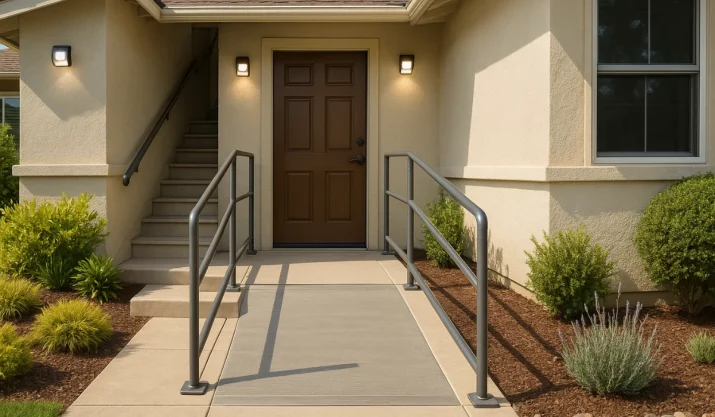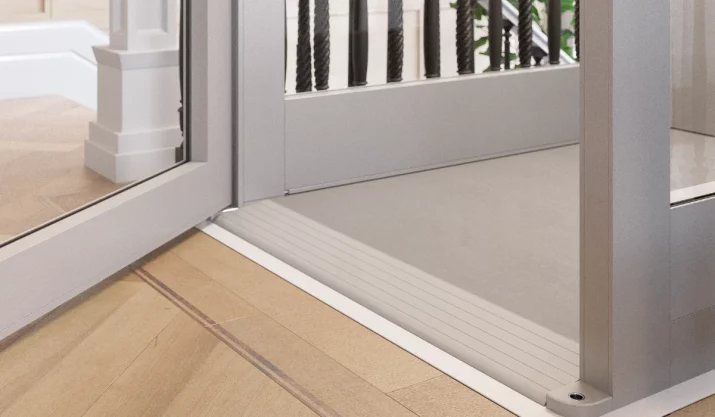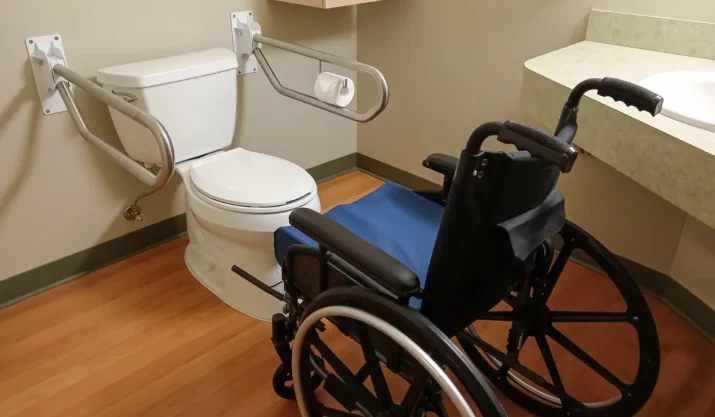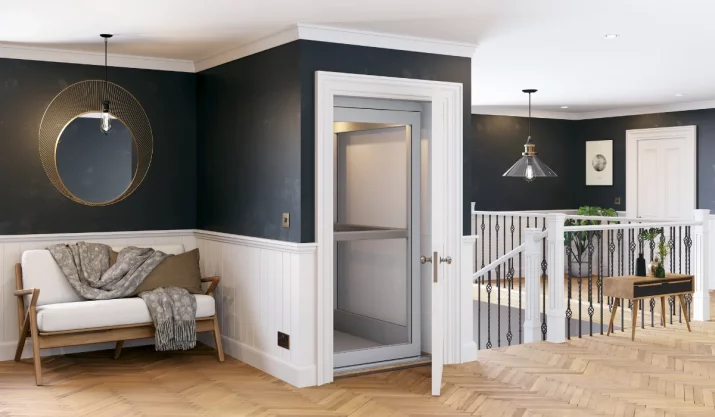How to Make a Raised Entryway Safe for Seniors

Table of Contents
- Key Takeaways:
- Why entryway safety matters for aging in place
- 1. Eliminate tripping hazards at the door threshold
- 2. Add handrails and grab bars for support
- 3. Improve lighting with motion-sensor lights
- 4. Make the entry door easier to use
- 5. Add a ramp or stairlift for easier access
- 6. Secure surfaces with non-slip materials
- 7. Ensure compliance with building codes
- 8. Think beyond the front door
- Final thoughts
- FAQs
Steps, uneven thresholds, or slippery surfaces can make a raised entryway difficult for older adults, especially if they use a wheelchair, walker, or cane. If you’re helping a loved one age in place, making the entryway safe is essential.
In this guide, you’ll learn how to create a safe entryway for seniors, including ways to reduce fall risks, improve accessibility, and help seniors stay independent for years.
Key Takeaways:
- Raised entryways can increase fall risk for seniors, especially those using mobility aids like wheelchairs or walkers.
- Threshold ramps, handrails, and slip-resistant materials are essential for creating a safe, accessible entry.
- Lighting matters. Install motion-sensor or smart lights to reduce accidents during low-visibility hours.
- Door hardware upgrades and smart home features improve daily usability and safety for older adults aging in place.
Why entryway safety matters for aging in place
Many California homes, especially older buildings in places like Los Angeles, the Bay Area, or Sacramento, have steps or high thresholds at the front door. While common, these design elements can create tripping hazards and raise the risk of falls for older adults.
According to the CDC, falls cause more injuries in seniors than any other accident. If your loved one wants to age in place or if you’re going to make your home safer for them when they visit, making your entryway safer should be one of your top priorities.
Aging in place means being able to come and go from your home without help. If your loved one’s home has a challenging entryway, a few key changes can improve their daily access and enhance overall well-being.
Also, having an accessible entryway can help boost your loved one’s ability to socialize, which is great for maintaining their emotional, physical, and social health.
1. Eliminate tripping hazards at the door threshold
Door thresholds are one of the most common causes of trips and falls at the entry. Even a half-inch lip can be dangerous for someone using a walker or wheelchair.
Here are simple ways to reduce this hazard:
- Install a threshold ramp: These low-profile threshold ramps create a smooth transition over raised thresholds or small steps. Look for models made of aluminum or rubber with non-slip surfaces.
- Level out uneven surfaces: Cracks in concrete or shifting porch tiles can become potential hazards. Repair or replace materials to create a flush, even walkway.
2. Add handrails and grab bars for support
Whether there’s a single step or several leading to your door, handrails provide critical balance support. Install handrails on both sides of the entry stairs or stairway, if possible.
In addition, consider installing grab bars near the door to provide extra stability while unlocking or opening the door. All hardware should be:
- Weather-resistant
- Mounted securely into studs or masonry
- Designed to support at least 250 lbs (ADA-compliant)
These supports help people with limited mobility or balance issues stay steady.
3. Improve lighting with motion-sensor lights
Poor visibility is another key contributor to falls. Many entries lack adequate lighting, particularly at night.
Consider:
- Motion-sensor lights: These activate automatically as someone approaches.
- Smart home lighting: Choose a lighting option that you can control through your phone. Lights with timer features can also be a convenient choice.
- LED bulbs with a bright, daylight color temperature to reduce shadows and improve clarity.
Good lighting improves visibility and makes movement safer, especially for caregivers, family members, or anyone providing in-home assistance.
4. Make the entry door easier to use
Doorknobs and heavy doors can be difficult for older adults to use. Here are helpful modifications:
- Replace traditional knobs with lever-style door handles, which are easier to grip and operate.
- Adjust the door’s tension to make it easier to open and close.
- Lower light switches and install smart locks or video doorbells for added security and ease of use.
These upgrades are beneficial for seniors with arthritis, mobility limitations, or who rely on healthcare professionals for in-home visits.
5. Add a ramp or stairlift for easier access
For homes with multiple stairs leading to the front door, a wheelchair ramp or stairlift may be necessary. These allow for easy access, whether someone uses a wheelchair, walker, or simply needs assistance navigating stairs.
Wheelchair ramps should follow ADA guidelines where possible, including:
- A 1:12 slope ratio
- Slip-resistant surface
- Handrails on both sides
- Landings at top and bottom
In tight spaces, a vertical platform lift or home lift may be a better fit.
A stairlift is ideal for a stairway leading to a porch or raised landing. It can provide safe transport up exterior stairs without the need for walking, reducing the physical strain on older adults and improving their overall quality of life.
6. Secure surfaces with non-slip materials
Even minor patches of slick concrete or smooth tile can pose a slipping risk. Consider these options:
- Apply non-slip flooring tape or mats on porches and stairs.
- Use slip-resistant paint or coatings on outdoor surfaces.
- Avoid placing throw rugs near the door, as they can bunch or shift underfoot. Instead, use fixed, slip-resistant mats.
In rainy seasons, these precautions significantly reduce the risk of slips and help maintain mobility.
7. Ensure compliance with building codes
Before starting any renovations, check your local building codes, especially if you’re adding a ramp, stairlift, or new lighting. California has specific ADA-related requirements for slope, height, and safety that may apply even in residential projects.
Get permits and follow codes to ensure both safety and property value. Many homeowners prefer to work with professional builders to avoid problems like making minor adjustments or redoing the project altogether.
Professional builders follow California’s ADA requirements to install ramps, stairlifts, or lighting that meet code, saving you costly rework later.
8. Think beyond the front door
If caregivers or home care providers use side or garage entries, add ramps, handrails, and motion-sensor lights there, too. Keep walkways clear of clutter for safe movement.
Tips:
- Extend your lighting upgrades to all entry points.
- Add accessibility features at side or garage entries.
- Remove clutter and keep walkways clear.
Holistic home safety planning supports secure, independent living and brings confidence to both seniors and their healthcare teams.
Final thoughts
A raised entryway shouldn’t be a barrier to comfort or independence. With thoughtful home modifications, you can make the home safer, improve well-being, and support long-term independence.
Whether you live in San Diego, Fresno, or anywhere in between, California Mobility is here to support seniors and caregivers with practical solutions tailored to your lifestyle. Creating a safe entryway for seniors isn’t just about access; it’s about dignity, confidence, and everyday comfort.
Contact us today, and our team will be happy to help you make your raised entry safe for your senior loved ones.






